Komatiite
Category: Volcanic
Type
Commons Komatiite is an ultramafic, high-magnesian volcanic rock typical of a spinifex texture originated during fast cooling of a silicate melt enriched in olivine and other Mg-Fe silicates. Komatiites occur only in Archean terranes. Temperatures of komatiitic melts attained as much as 1400 °C and more. Such super-hot melts cannot form recently owing to a lower thermal gradient in the lithosphere and the mantle. Komatiites occur in old south-African cratons around the Komati river, from where the rock was described for the first time. They also occur in the Ontario province, Canada, in the Kamchatka peninsula, Russia, in Australia and Columbia.
Name origin Komatiite was named after type locality – the Komati river in Kaapvaal Craton (the Barberton belt) in the South-African Republic.
Locality Komati River, Kaapvaal Craton (the Barberton belt), JAR (sample courtesy of M. Kohút).
GPS:
Major minerals Forsterite olivine (Fo≥90), Ca-Cr pyroxene creating porphyric phenocrysts with skeletal and needle/like shapes, Ca-plagioclase (An≥85) is a groundmass phase together with glass.
Accessory minerals Chromite.
Classification Komatiite is a high-Mg volcanic rock. Its SiO2 ranging at 30 – 52 wt. % and Na2O a K2O (< 2 hmot. %) contents project in the TAS diagram in the fields of basalt, picrobasalt or foidite (shaded area). However, it discriminates from these rock types by a high MgO (> 18 wt. %) and TiO2 contents (< 1 wt. %). Meimechite is a similar rock type with identical SiO2, alkalis and MgO contents, however, it differs by an increased TiO2 content, > 1 wt. %. Kerr and Arndt (2001) proposed to avoid the strictly chemical classification of komatiites and to consider only the typical spinifex texture. This should discriminate some picrites without the corresponding texture to be classified as komatiites.
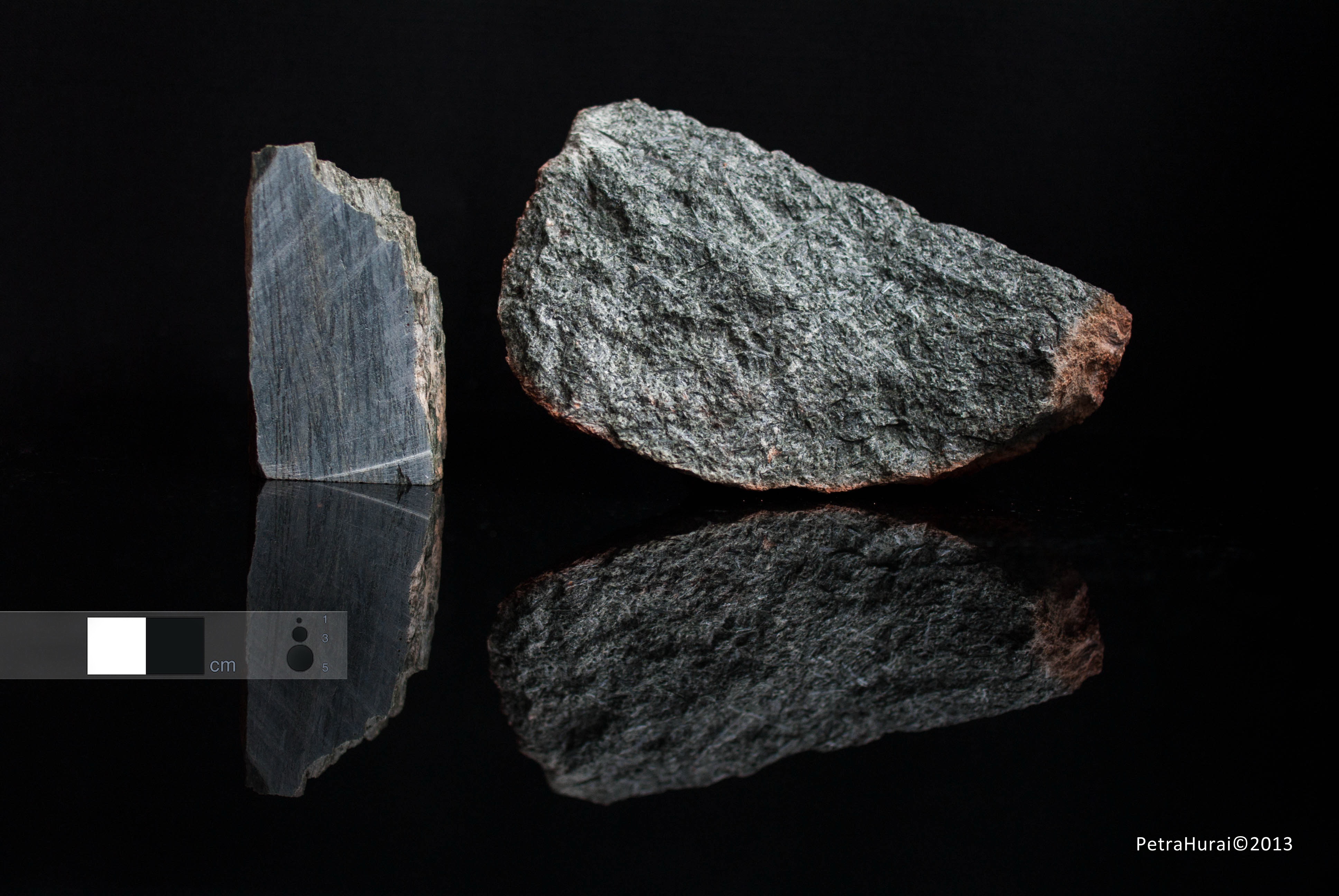
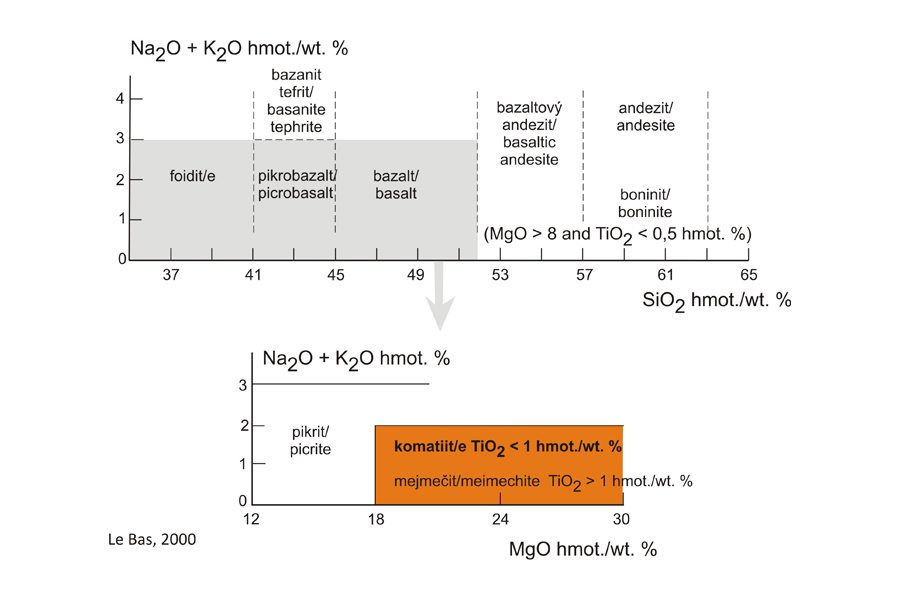
Colour Black, grey, locally grey-green.
Structure Pillow-like, porphyric, spinifex.
Granularity Finely grained to glassy groundmass with skeletal and bladed olivine phenocrystals up to several dm
Texture Porphyric - spinifex.
Alterations The rock is moderately serpentinized.
Petrographic characteristics Almost all komatiites are metamorphosed, thus correspoding in fact to metakomatiites. However, the prefix meta is usually left out. Komatiites form lava flows of small thickness within basaltic volcanic fields. Ultramafic komatiites display the spinifex texture named after an Australian grass. The texture originates during rapid quenching of melts rich in olivine crystallites. They are often replaced by secondary minerals. Typical spinifex-type komatiites are characteristic of mutually intersecting bladed olivine crystals.
Usage The rock does not have a practical utilization. However, komatiite samples are of great scientific value, because they are extremely rare.
Literature Arndt, N. T., 1985: Differentiation of komatiite flows. Journal of Petrology, 27, 279-301. Arndt, N. T., 2003: Komatiites, kimberlites, and boninites. Journal of Geophysical Research, 108, 1–11. Grove, T. L., Parman, S. W. & Dann, J. C., 1999: Conditions of magma generation for Archean komatiites from the Barberton Mountainland, South Africa. In: Fei, Y., Bertka, C. & Mysen, B. O. (eds) Mantle Petrology: Field Observations and High Pressure Experimentation: a Tribute to Francis R. (Joe) Boyd. Geochemical Society Special Publication 6, 155–167. Kerr, A.C., 2005: La Isla de Gorgona, Colombia: A petrological enigma? Lithos, 84, 77-101. Kerr, A.C. & Arndt, N.T., 2001: A Note on IUGS Reclassification of the High-Mg and Picritic Volcanic Rocks. Journal of Petrology, 42, 11, 2169-2171. Baskabakalarka2014 Parman, S. W., Dann, J. C., Grove, T. L. & de Wit, M. J., 1997: Emplacement conditions of komatiite magmas from the 3.49 Ga Komati Formation, Barberton Greenstone Belt, South Africa. Earth and Planetary Science Letters, 150, 303–323. Parman, S.W., Shimizu, N., Grove, T.L., & Dann, J.C., 2003: Constraints on the pre-metamorphic trace element composition of Barberton komatiites from ion probe analyses of preserved clinopyroxene. Contrib. Mineral. Petrol. 144, 383-396. Puchtel, I.S., Brandon, A.D. & Humayun, M.: 2004: Precise Pt–Re–Os isotope systematics of the mantle from 2.7-Ga komatiites. Earth Planet. Sci. Lett. 224, 157-174. Sun, S. S., 1987: Chemical composition of Archaean komatiites: implications for early history of the Earth and mantle evolution. In: Weaver, S. D. & Johnson, R.W., (eds) Tectonic Controls on Magma Chemistry. J. Volcanol. Geotherm. Res., 32, 67-82.
Photomicrographs
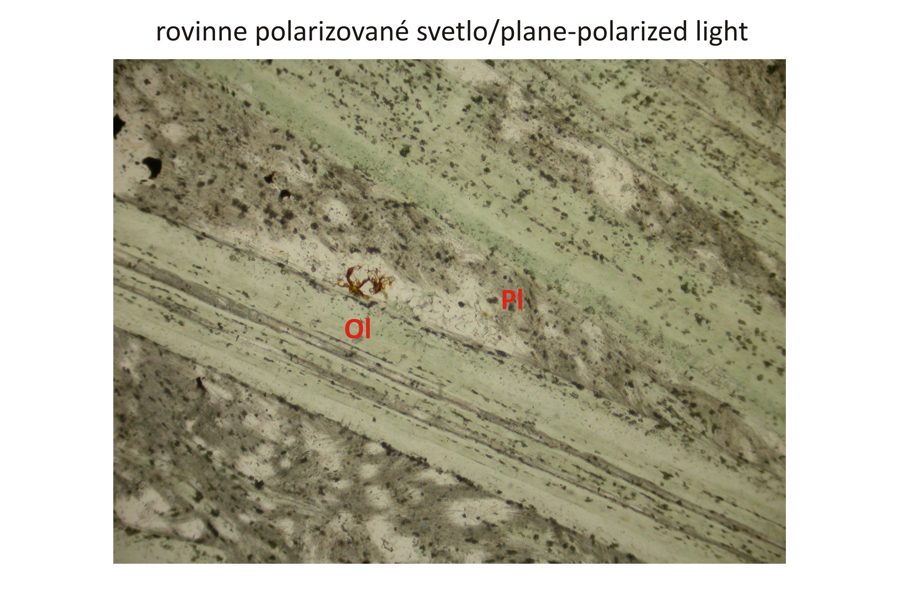
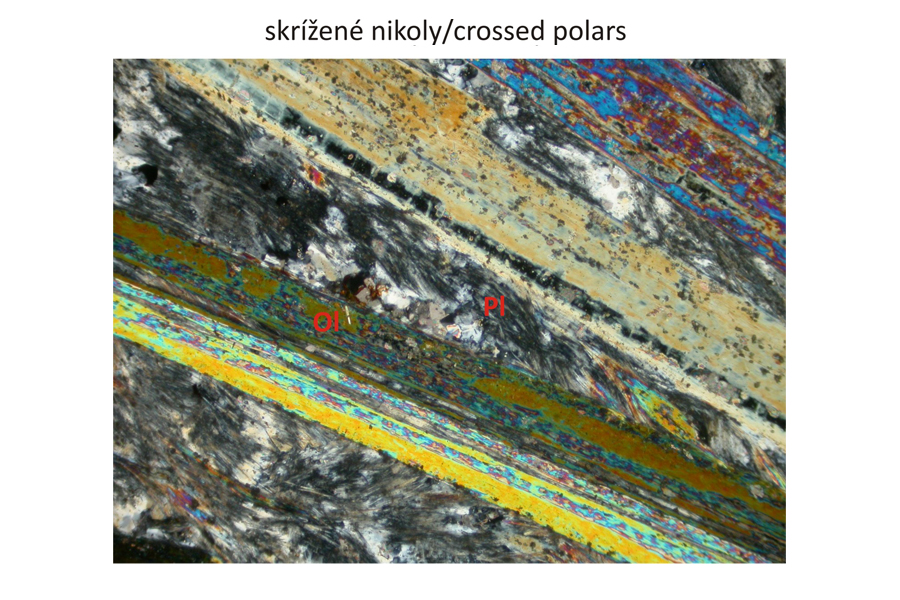
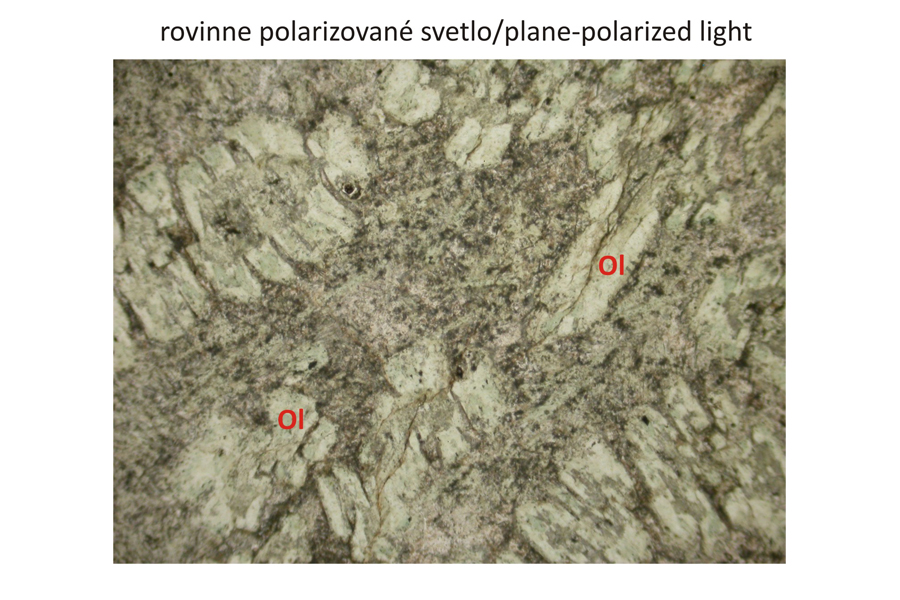
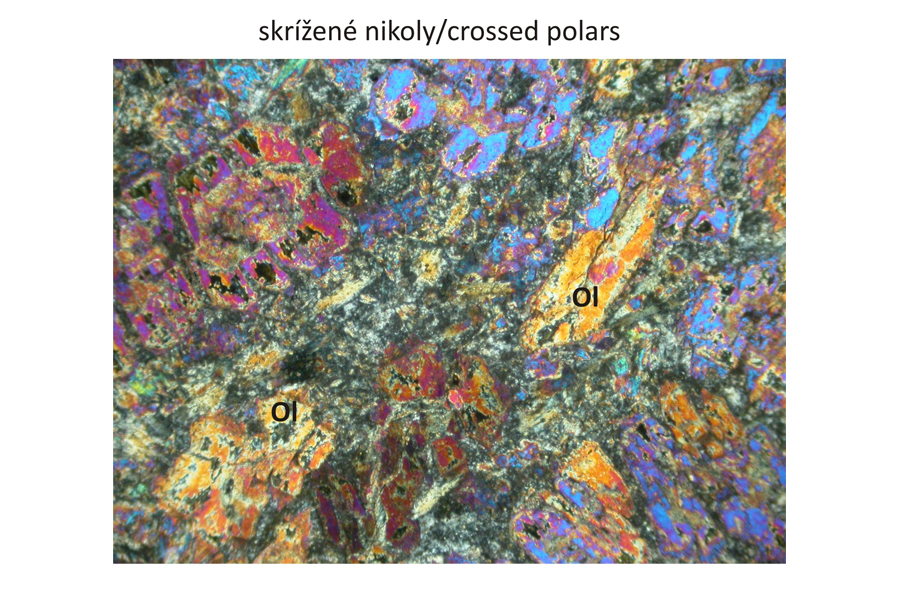
Elongated needle-like olivine phenocrysts – Ol originated during rapid cooling of high-Mg melt, embedded within finely grained matrix composed of glass and plagioclase – Pl. Photomicrographs in the upper row show cross-sections oriented parallel with the olivine phenocrystals. The lower row of photomicrographs shows the cross-section oriented perpendicular to the oriented olivine phenocrysts, which appear as rounded or short-prismatic grains. The groundmass is less distinctive here.Width of all photomicrographs is 2.2 mm.
Normative composition
Komatiite is a quartz-saturated rock. The low silica content is compensated by the formation of normative olivine - ol from the provisional hypersthene – hy´. The high magnesium content is projected in the normative olivine – ol, hypersthene – hy and diposide - di. The high Ca content is obvious from the presence of the normative diopside - di and anorthite – an.
Normative minerals
SiO2
TiO2
ZrO2
Al2O3
Fe2O3
FeO
MnO
MgO
CaO
Na2O
K2O
P2O5
F
S
CO2
Total
Molar proportion of normative mineral
Molecular mass of normative mineral
Weight % of normative mineral
Oxide
(wt. %)
47.20
0.30
3.40
11.20
0.20
31.40
5.60
0.07
0.04
0.02
99.43
Molecular
weight
60.08
79.88
101.96
71.85
70.94
40.31
56.08
61.98
94.20
141.95
Molecular
proportion
0.7856
0.0038
0.0333
0.1587
0.0028
0.7790
0.0999
0.0011
0.0004
0.0001
ap
0.0005
0.0001
0.0001
328.68
0.05
il
0.0038
0.0038
0.0038
151.75
0.57
or
0.0025
0.0004
0.0004
0.0004
556.67
0.24
ab
0.0068
0.0011
0.0011
0.0011
524.46
0.59
an
0.0636
0.0318
0.0318
0.0318
278.21
8.84
zvyšky
0.1549
0.7790
0.0676
di
0.1352
0.0112
0.0564
0.0676
0.0676
221.79
14.99
hy´
0.8663
0.1437
0.7226
0.8663
105.62
91.50
ol
0.2888
0.0479
0.2409
0.2888
151.16
43.65
hy
0.2887
0.0958
0.4817
0.2887
105.62
30.50
D: 0.2888
D1: -0.1444
Mg/(Mg+Fe2+): 0.834
Total of normative wt. % 99.43
Comment A portion of the provisional normative hypersthene – hy´ was used for the creation of the normative olivine ol and real hypersthene – hy.
Chemical composition
Two geochemical types of komatiites are distinguished: the Barberton type is depleted in Al and has a low Al2O3/TiO2 ratio accompanied by moderately increased contents of incompatible elements. Shapes of REE distribution curves are flat to mildly fractionated, with significantly depleted HREE resulting in a high Gd/Yb ratio. The Barberton type is common in the oldest (3.5 Ga) Archaic greenstone belts. The Munro type is the second geochemical type, which is not depleted in Al and has a higher, near-chondritic Al2O3/TiO2 ratio and lower contents of incompatible elements. The Munro type occurs in 2.7 Ga old Archaic greenstone belts and in some Proterozoic and younger regions. For instance, the youngest known komatiite occurs in the Gorgona Island in the Pacific ocean. Komatiites are also typical of high Ni (up to 2000 ppm) and Cr (up to 5500 ppm) contents.
-
SiO2
47.6TiO2
0.27Al2O3
3.1FeO
9.8MnO
0.20MgO
31.6CaO
6.51Na2O
0.00K2O
0.02P2O5
0.02Total
99.2Mg(Mg/Fe2+)
0.85
Spinifex zone, greenstone belt Barberton, Parman et al., 2003.
-
SiO2
45.4TiO2
0.35Al2O3
7.25Fe2O3
11.90MnO
0.18MgO
26.8CaO
6.96Na2O
0.50K2O
0.06P2O5
0.02LOI
6.11Total
100.4Mg(Mg/Fe2+)
0.82
Greenstone belt Abitity, Puchtel et al. 2004.
-
SiO2
44.56TiO2
0.64Al2O3
11.17Fe2O3
12.70MnO
0.20MgO
20.11CaO
9.88Na2O
0.68K2O
0.03P2O5
0.05LOI
5.19H2O+
1.89Total
100.01Mg(Mg/Fe2+)
0.76
Youngest known komatiite, Kerr, 2005.
-
SiO2
46.1TiO2
0.25Al2O3
3.7FeO
9.9MnO
0.17MgO
33.5CaO
3.80Na2O
0.13K2O
0.07P2O5
0.03Total
97.70Mg(Mg/Fe2+)
0.86
Cumulate zone, greenstone belt Barberton, Parman et al., 2003.


